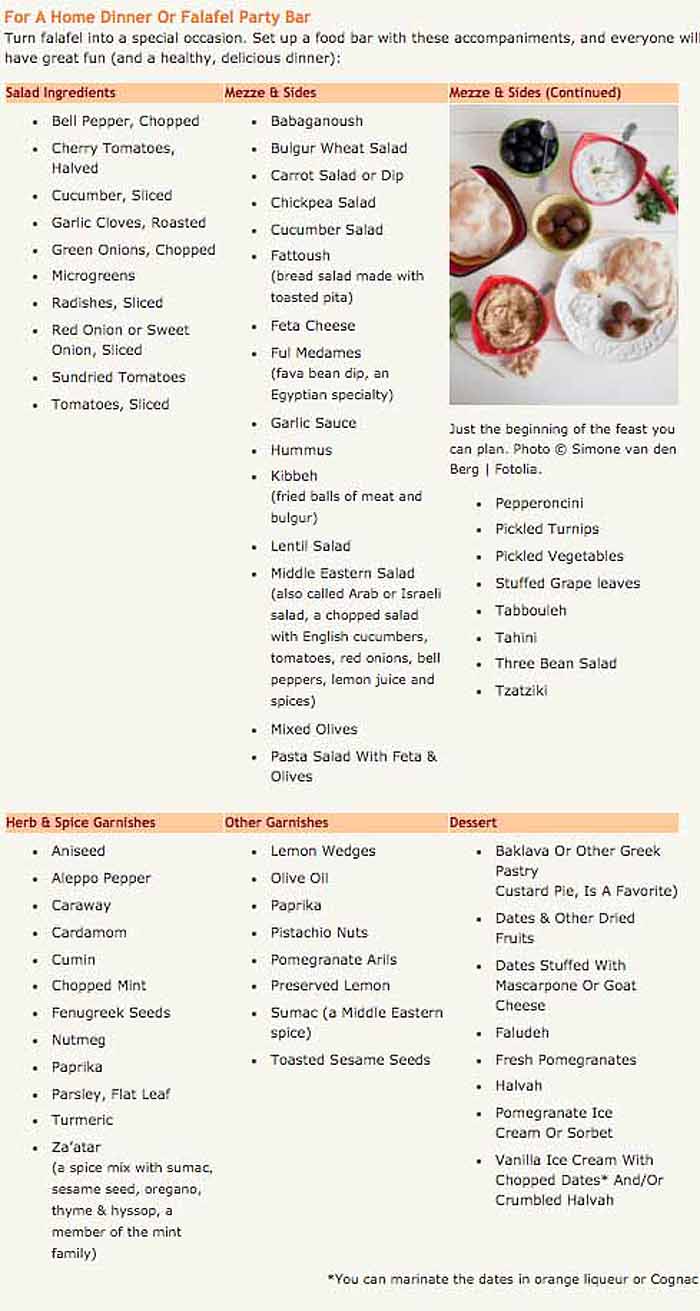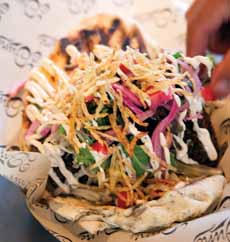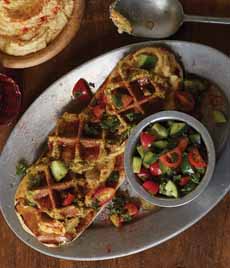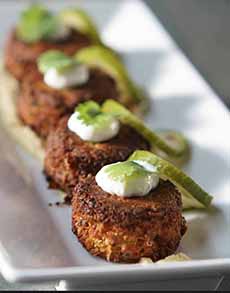Trending Ways To Serve Falafel & A Falafel Party Bar
|
For those who don’t know falafel: It’s a vegan, protein-rich, fiber-rich, gluten*-and-other-allergen-free ball—sometimes a patty—of goodness, fried† to crunchy crispiness (photo #1), that has captivated food lovers the world over. It’s so meaty and chewy that newbies often don’t realize it’s meatless. The ingredients include mashed chickpeas, fava beans, or a combination. In better recipes, lots of chopped cilantro and/or parsley and spices are highlights. The inside of a good falafel ball should have lots of green herb flecks. At our favorite falafel place, the interior of the ball is half-green from parsley. Falafel is traditionally served in a pita pocket (photo #2), wrapped in a flatbread (photo #3), or added to a mezze† plate or a salad plate. (MINI-TIP: Go for a whole wheat pita. It’s more flavorful and contributes toward your 48g of whole grains). Falafel makes a filling lunch or snack. But there are a dozen more ways to enjoy falafel, below. Want to make your own falafel? Here’s the recipe and cooking tips. June 12th is International Falafel Day. Some food historians believe that falafel originated in Egypt, as a food for early Christians who observed meatless holidays like Lent. It was made from the plentiful fava bean harvest, and today is one of Egypt’s national dishes. Falafel then migrated northward to the Levant**, where local chickpeas replaced the fava beans. Just think: If Saint Mark hadn’t established the Church of Alexandria in 43 C.E., (today the Coptic Orthodox Church), we might not have falafel! In Arabic, the word means both “hot peppers” and “fluffy.” Today’s falafel doesn’t have to be either. In North America prior to the 1970s, falafel was found only in Middle Eastern, Mediterranean, and Sephardic Jewish neighborhoods and restaurants. The growth in vegetarianism and veganism spurred its spread. Today, falafel is a popular casual fare in many cities in the U.S., as well as in Canada. The conventional Middle Eastern treatment tucks balls of falafel into a pita pocket with a raw or pickled vegetable garnish (carrots, onions, turnips) and a creamy drizzle of tahini (tehina). Some restaurants and falafel stands substitute hummus for the drippier tahini, which can soak through the pita. Hot sauce is optional. The most common version of falafel served in the U.S. combines chickpeas, chickpea flour, garlic, spices, and sometimes fresh herbs and scallions. The blend is typically rolled into balls, sometimes flattened, patty style, then deep-fried until golden and crunchy. Another appeal of falafel is that, like a slice of pizza, it can be eaten sitting down or on the go. Whether as a sandwich or a snack, deep-fried food is always popular with Americans. In addition to bar snacks with a dip—not necessarily a Middle Eastern dip—today’s chefs have adapted the classic recipe in appealing ways: You can buy frozen falafel, fry or bake your own (here’s a recipe), or purchase any or all of the ingredients from your nearest falafel emporium. |
|
|
 Chart © The Nibble. __________ *Traditional falafel is gluten-free, but read the label. Some manufacturers add wheat flour or wheat germ to the balls don’t fall apart. Potato flour, soy flour, and soy protein can also be added. Recipes that use bread crumbs or flour can use gluten-free options. †For frying falafel, canola oil, and peanut oil are monounsaturated fats (good for you fats). To cut down on fat calories, you can bake the falafel instead of frying. ‡Mezze are assorted dips and spreads and also include babaganoush, hummus, tabbouleh, eggplant dip, and other local favorites. **The Levant included modern Israel, Jordan, Lebanon, the Palestinian Territories (the West Bank and the Gaza Strip), and Syria.
|
||





